Nebuchadnezzar II › Torah » Ancient origins
Articles and Definitions › Contents
- Nebuchadnezzar II › Who Was
- Torah › Antique Origins
Ancient civilizations › Historical and archaeological sites
Nebuchadnezzar II › Who Was
Definition and Origins
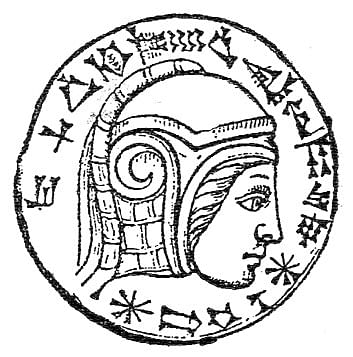
King Nebuchadnezzar II (634-562 BCE) was the greatest king of ancient Babylon, succeeding his father, Nabopolassar. King Nabopolassar had defeated the Assyrians with the help of the Medes and liberated Babylonia from Assyrian rule. In this way he provided for his son (as Philip II would do for his son Alexander later) a stable base and ample wealth on which to build;an opportunity for greatness which Nebuchadnezzar took full advantage of. He married Amytis of Media (630-565 BCE) and so secured an alliance between the Medes and the Babylonians (Amytis being the daughter or granddaughter of Cyaxerxes, the king of the Medes) and, according to some sources, had the Hanging Gardens of Babylon built for her to remind her of her homeland in Persia.
Upon ascending to the throne, Nebuchadnezzar spoke to the gods, in his inaugural address, saying, “O merciful Marduk, may the house that I have built endure forever, may I be satiated with its splendor, attain old age therein, with abundant offspring, and receive therein tribute of the kings of all regions, from all mankind” and it would seem the gods heard his prayer in that, under his reign, Babylon became the most powerful city-state in the region and Nebuchadnezzar II himself the greatest warrior-king and ruler in the known world. He is portrayed in unflattering light in the Bible, most notably in the Book of Daniel and the Book of Jeremiah (where he is seen as an 'enemy of God' and one whom the deity of the Israelites intends to make an example of or, conversely, the agent of God used as a scourge against the faithless followers of Yahweh ). Those portraits notwithstanding, Nebuchadnezzar II was most certainly responsible for the so-called Babylonian Exile of the Jews and, so, for the formation of modern-day Judaism (in that, the temple destroyed, the Priestly class of the Levites of the Jews had to re-create their religion “in a foreign land” as recounted famously in Psalm 137 from the Bible, and elsewhere).
Upon ascending to the throne, Nebuchadnezzar spoke to the gods, in his inaugural address, saying, “O merciful Marduk, may the house that I have built endure forever, may I be satiated with its splendor, attain old age therein, with abundant offspring, and receive therein tribute of the kings of all regions, from all mankind” and it would seem the gods heard his prayer in that, under his reign, Babylon became the most powerful city-state in the region and Nebuchadnezzar II himself the greatest warrior-king and ruler in the known world. He is portrayed in unflattering light in the Bible, most notably in the Book of Daniel and the Book of Jeremiah (where he is seen as an 'enemy of God' and one whom the deity of the Israelites intends to make an example of or, conversely, the agent of God used as a scourge against the faithless followers of Yahweh ). Those portraits notwithstanding, Nebuchadnezzar II was most certainly responsible for the so-called Babylonian Exile of the Jews and, so, for the formation of modern-day Judaism (in that, the temple destroyed, the Priestly class of the Levites of the Jews had to re-create their religion “in a foreign land” as recounted famously in Psalm 137 from the Bible, and elsewhere).
NEBUCHADNEZZAR II DEFEATED THE EGYPTIANS AND THE ASSYRIANS AT CARCHEMISH, SUBDUED PALESTINEAND SYRIA AND CONTROLLED ALL THE TRADE ROUTES ACROSS MESOPOTAMIA.
Nebuchadnezzar II defeated the Egyptians and their allies the Assyrians at Carchemish, subdued Palestine and the region of Syria and, consolidating his power, controlled all the trade routes across Mesopotamia from the Persian Gulf to the Mediterranean Sea. Remaining true to the vision of his inaugural address, the great king spent the tolls he collected and the taxes he gathered in creating a city which, he hoped, would be recognized as a wonder of the world (and, indeed, his hopes were realized in later writers adding the walls of Babylon and, in particular, the Ishtar gate to the list of the Seven Wonders of the World). In the forty-three years of his reign, Nebuchadnezzar II made the most of the time employing a vast army of slave labor to surround his city with walls so thick that chariot races were conducted around the tops and which stretched fifty-six miles in length, encircling an area of two hundred square miles. The bricks of the walls were faced with a bright blue and bore the inscription, “I am Nebuchadnezzar, King of Babylon.”
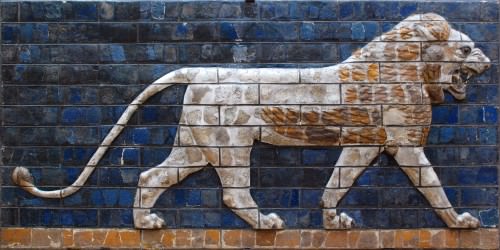
Lion of Babylon
Torah › Antique Origins
Definition and Origins
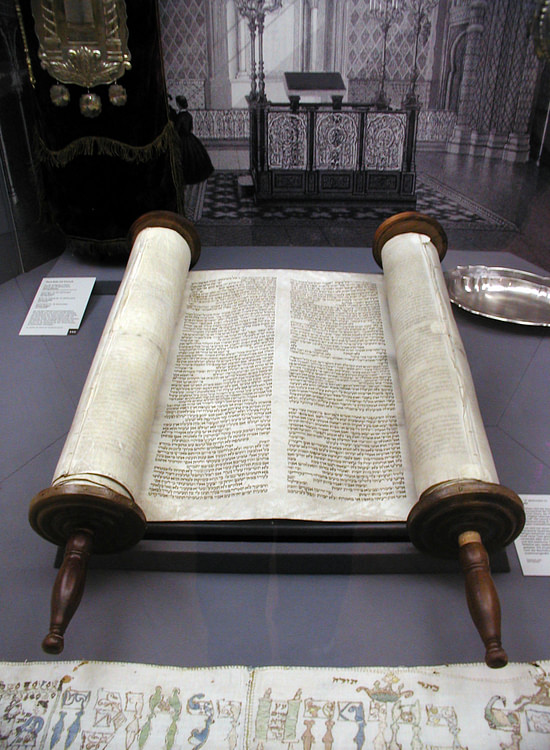
The Torah, also known as the Pentateuch (from the Greek for “five books”), is the first collection of texts in the Hebrew Bible.It deals with the origins of not only the Israelites, but also the entire world. Though traditionally the Hebrew word torah has been translated into English as “law” because of its translation in the Septuagint (the Greek translations of the Hebrew Bible) as nomos (law), it is better understood and translated as “teaching” or “instruction.” The Torah is the result of a long process of editing (or redaction, as it is called by scholars). This means that there is no one date that one can be pointed to as the date of composition. Most scholars think that the final major redactions took place after 539 BCE, when Cyrus the Great conquered the Neo-Babylonian Empire. The Torah was, and continues to be, the central set of sacred texts (scriptures) for Judaism because of its focus on the proper ways (ritually, ethically, theologically, etc.) for the tribes of Israel to live, though how exactly one is to live out the Torah was, and continues to be, a complicated issue.
STRUCTURE
The Torah is composed of five books which present us with a complete narrative, from creation to the death of Moses on the banks of the Jordan River. The question of the relationship between history and the narratives of the Torah is complex. While the Torah mentions historical places (eg Ur in Genesis 11) and historical figures (eg Pharaoh in Exodus 1, perhaps Ramses II), we have no archaeological or other textual record of the specific events or the key players (eg Moses) described.
THE TORAH IS COMPRISED OF FIVE BOOKS WHICH PRESENT US WITH A COMPLETE NARRATIVE, FROM CREATION TO THE DEATH OF MOSES ON THE BANKS OF THE JORDAN RIVER.
Genesis
Genesis is broken up into four literary movements. The first movement is known as the “primeval history,” which tells the story of the world from “creation” up to the call of Abraham. The second movement is the Abraham cycle, chapters 12.1-25.18, which tells the story of Abraham from his call to his death. The third movement, chapters 25.19-36.43, is the Jacob cycle which tells the story of Jacob from his birth up to the dreams of his son Joseph. The fourth movement, chapters 37-50, is the Joseph cycle which tells the story of Joseph and his brothers. The narrative of Genesis begins with the creation of the world, but with each movement the narrative becomes more focused. It moves from focusing on the entire created order, to humanity, to focusing on a specific family (that of Abraham), to focusing one of Abaraham's sons (Jacob/Israel), and culminating in the “creation” of the tribe of Israel and the presence of Israelites in Egypt.
Exodus
Exodus can be broken up into three general sections: the liberation from Egypt (chapters 1.1-15.21), the giving of the Law to Moses on Sinai (15.22-31.18), and the start of the 40 year (one generation) desert wandering (32-40).
Leviticus
In contrast to the rest of the Torah, Leviticus contains very little narrative material, but is dependent upon the narrative of Exodus. The material of the P source (see below) in Exodus primarily describes the construction of the cultic implements (eg the Ark of the Covenant). In Leviticus the focus is on the enactment of the cult, particularly the role of the Levites, which is to teach the distinction “between the holy and the common, and between the clean and unclean” (Lev 1.10; 15.31, NRSV).
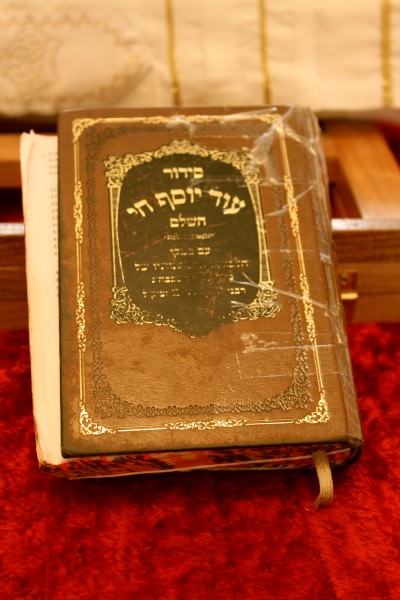
Torah, Baku
Numbers
There are two ways to understand the structure of Numbers. First, one can view its structure as geographic, with each section corresponding to a particular location in the desert wandering: Wilderness of Sinai (1.1-10.10), the land east of the Jordan River, also known as "Transjordan" (10.11-22.1), and the land of Moab (22.2-36.13). However there are two key events which can also be used to understand the structure of the book, the two military censuses of chapters 1 and 26.
Deuteronomy
Deuteronomy gets its English name from the Greek word deuteronomion (second law), which is a poor translation of the Hebrew phrase mishneh hattorah hazzot (a copy of this law) in Deuteronomy 17.18. It is also the only book of the Torah to make specific claims for Mosaic authorship.
Four editorial superscriptions make the structure of Deuteronomy clear. Part 1 (1.1-4.43) is primarily Moses reflecting on the story of the Israelites from Sinai (or Horeb as it is called in Deuteronomy) to Transjordan and a discussion on the destiny of God's people. Part 2 (4.44-28.68) is the key part of the book as it contains the giving of the Torah (the authoritative teaching and instruction) dictating how Israel is to live (ethically, cultically, politically, socially, etc.) if it wants to secure its political existence. Part 3 (29-32) contains a covenant Moses makes with Israel and relates the commissioning of Joshua. Part 4 (33-34) concludes with blessing of the tribes of Israel, and a narrative about the death and burial of Moses. Deuteronomy, and as such the Torah, concludes with the people of Israel poised to enter the promised land.
COMPOSITION
Traditionally, it was largely assumed (by Jews and Christians alike) that Moses was the author of the Torah. However, in the 17th century CE, this assumption began to be challenged. In the 19th century CE, German scholar Julius Wellhausen put forth the first major formulation of what is known as the Documentary Hypothesis in his Prolegomena zur Geschichte Israels (first published in German in 1878 CE, and in English as Prolegomena to the History of Israel in 1885 CE). Since then, the Documentary Hypothesis has undergone significant revision and among many scholars, particularly those in North America, it remains the dominant theory for explaining the composition of the Torah.
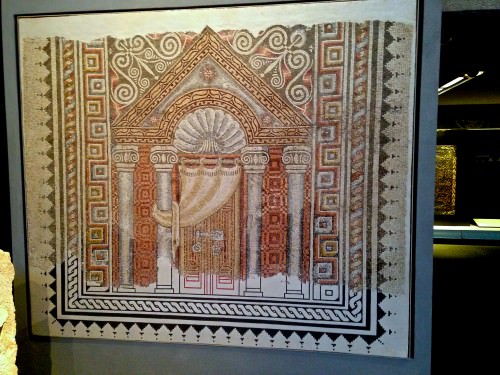
Mosaic of Temple Facade with Torah Ark
Simply put, this theory states that the whole of the Torah is comprised of four main sources: J (Yahwist), E (Elohist), D (Deuteronomistic), and P (Priestly). It is most likely that these sources are not texts, but particular groups of individuals who were initially responsible for the composition and transmission of the souces (as oral traditions and/or written compositions) which were later incorporated into the Torah by the P source. Scholars use "source" in a very general way in this context to allow for the ambiguity of what these "sources" were.
The J source earns its name from the fact that it prefers the Tetragrammaton (“The four letters”), YWHW (usually pronounced as “ yahweh,” though this pronunciation is debated), for the name of the god of Israel. The reason that it is the "J" source and not the "Y" source is that the theory was first put forth in Germany, where YHWH is spelled with a J rather than a "Y." YHWH is made to appear very human (eg YHWH is said to walk with humans [see Genesis 2]), the characters of Abraham, Isaac, and Jacob are not idealized in the narrative, and morality is not absolute. Further, it is the nation of Judah which is emphasized.This source is traditionally dated between 1000 BCE and 900 BCE, which possibly is contemporaneous with the courts of David and Solomon.
Like J, the E source gets its name from its preferred name for the god of Israel. It uses the generic Hebrew word elohim, which can mean “gods,” “god,” (as generic terms for other deities), or as “God” (referring specifically to the god of Israel). In contrast to J, E emphasizes the Northern Kingdom of Israel. Instead of directly speaking to humanity, the E source had God speaking directly to Abraham. This source is usually dated in the 8th or 9th centuries BCE and was likely an import from the Northern Kingdom of Israel. E and J were likely edited together at a point before the exilic period with J being the primary source with E edited in. Therefore, some scholars treat J and E as one source (calling it the JE source) or leave out E altogether.
D, or the Deuteronomist, is most likely a school of scribal reformers from around the time of Josiah, c. 621 BCE, a king of the Kingdom of Judah. D is responsible for the book of Deuteronomy and little else in the Torah. However, it is likely responsible (as authors and/or editors) for the books of Joshua, Judges, Samuel, Kings (known as the Deutronomistic History) as well as editor of Jeremiah and sections of the Book of the Twelve ( Hosea-Malachi ). D is characterized by absolute morality, worship centered in the Jerusalem Temple, and the cycle of sin and repentance. It is possible that some form of what we know as Deuteronomy was found by Josiah's High Priest as recorded in 2 Kings 22 and 2 Chronicles 34.
P, or the Priestly Source, is the most easily identified of the three sources responsible for Genesis – Numbers. This source is characterized by outlines, order, genealogy, and ritual and sacrifice. Like J, P focuses on Judah. Whereas JE is clearly narrative, P contains both narrative (such as the creation account in Genesis 1 and the flood narrative of Genesis 6—8) and ritual material (such as the Holiness Code of Leviticus 17—26). This makes it very difficult to characterize the genre of P. It is usually thought to be the last of the four sources to compose and redact the Torah, likely active sometime during the Persian period 539 - c. 330 BCE.
The Documentary Hypothesis is not without its problems. It has long been recognized that E lacks a clear narrative flow. If it was ever an independent source, it was long absorbed into J. For this reason, scholars are moving to talking about JE rather than J and E. Like E, it is difficult to identify a continuous J narrative running through the whole of the Torah.
Further, despite being the only source which can be readily identified running through the whole Torah, it seems that P is not really an independent source, but was intentionally composed so as to fit into the narrative material of J and E. Narrative disconnects between Genesis and Exodus make a continuous source running from Genesis to Numbers unlikely. For example, only a few verses (Genesis 50.14, 24; Exodus 1.8-7) superficially account for the transition from Joseph as the second most powerful person in Egypt to being unknown by the pharaoh, and the Israelites as nomads in Canaan to slaves in Egypt. Also, only a single passage in Genesis (15.13-16) gives any indication that the Israelites will have to leave Canaan first, and then return to the promised land.
In light of these issues, among European scholars there is a general move away from the traditional understanding of the Documentary Hypothesis, to understanding Genesis and the Moses story (Exodus and following) to be two competing origin narratives which were later edited together by the P source. They still see J and E (or JE) in Genesis, but do not think that J or E are complete sources running through the whole of the Torah. P is still seen as the final redactor and D is still responsible for the Deuteronomistic History.
LICENSE:
Article based on information obtained from these sources:with permission from the Website Ancient History Encyclopedia
Content is available under License Creative Commons: Attribution-NonCommercial-ShareAlike 3.0 Unported. CC-BY-NC-SA License